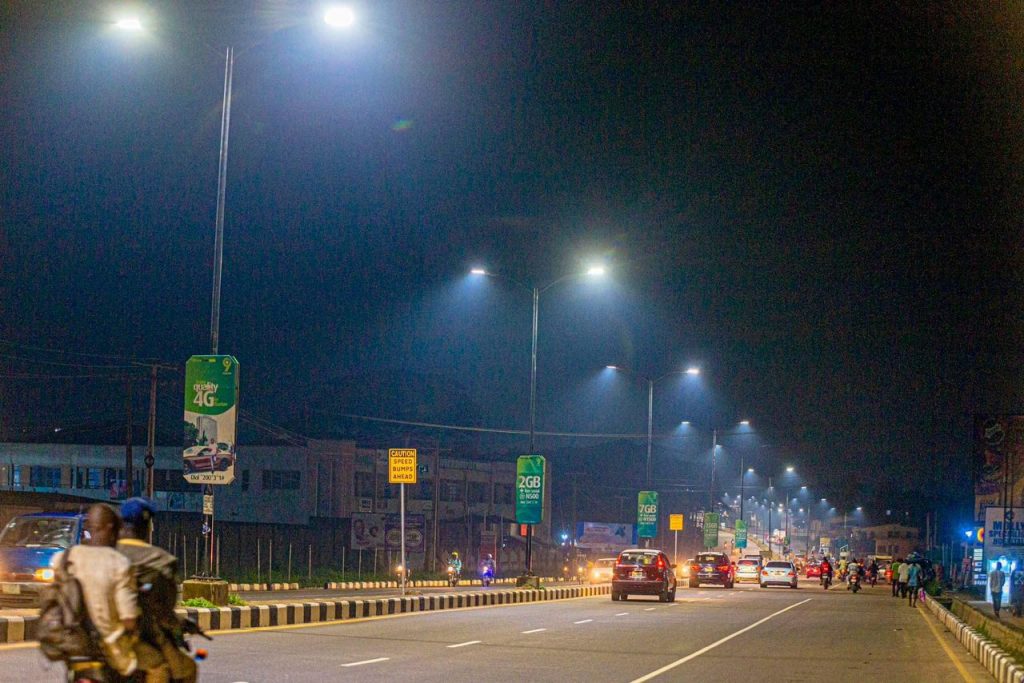
Background:
Few months into the first term of His Excellency, Engr. Oluseyi Makinde, the State government instituted the Light Up Oyo Project, which was targeted to cover over 240km of roads throughout the State.
According to the design and roadmap to the implementation of the project, it was aimed at improving the economy of the state by ensuring that the state economy does not go to bed at sunset. This initiative, when it was first introduced was said to be under the Ministry of Works and Transport in the state, and was highly commended by the people immediately the project kicked off and various towns began to be lit.
The project, if successful, will not only improve the economic activities of people in the State, but also helps to address challenges of insecurity confronting the State.
The Project:
The 240km street light project tagged Light Up Oyo was aimed to cover all the geopolitical zones in the State, from Ibadan to Oyo to Oke-Ogun to Ogbomoso and to Ibarapa for the good people of Oyo State. There is no gainsaying in the fact that this laudable project will bring economic development to the state. However, poor implementation of the project has been a major setback holding down its progress.
The funding arrangement was on Independent Power Producer IPP with the contractor providing larger percentage of the funding and Oyo State government fulfilling its own part too till the project is finally handed over to the State government after the agreed number of years.

According to findings, the street lights were to be powered by tribrid energy source grid, gas and inverter, with diesel as the first means for test running of the project.
What Went Wrong?
After 2years of the project, darkness has returned to the State, most especially in key areas where the project has been carried out. As the darkness looms, it is not out of point, if people begin to ask questions as regards the setback of the project and its failure to meet up with expectations.
Findings further reveal that the project started to fail immediately it was moved from Ministry of Works to Ministry of Energy, as it was alleged that those who were appointed to be in charge at the new ministry didn’t study the already-prepared contractual document developed by the Ministry of Works on the roadmap to implementation of the project via-a-vis transition from diesel to gas and Inverter.
It is a fundamental defect for a project of this magnitude to be allowed to go through its life cycle, without a designated dedicated champion. It is even problematic, if not chaotic, when one observes, that the implementation that goes with rigorous supervision is, in this case, left in the hands of inexperienced politicians, who too, possess no clue or any background knowledge of the complexities that normally come with managing such engineering technicalities necessary to pilot the project to a successful execution.
The idea of entrusting a handler and negotiator without requisite knowledge to champion this gigantic project, instead of assigning such role to a seasoned and tested professional engineer, detracts from the excellent merit the government pontificates about.
Another disturbing aspect of the detected flaws in the Light Up contract, is the project’s heavy concentration on “low hanging fruits”, that is, some noticeable short term hurriedly carried out meeting arrangements culminating into quick-fix problems and challenges, the solution to which could give a shot in the arm, to the prevailing problem.
The Issues:
The rising cost of diesel during the early implementation stage (2019 to 2020) hindered the effective functioning of the street lights making some people in the state to speak up and ask questions as regards the project. The government agreed that the project wasn’t meant to be placed on diesel and that they are doing all possible best on its transition to gas.
In 2022, the government successfully started transition from diesel generator to gas generator, still the lingering issues still persist.
In April 25th, 2023, the Honorable Commissioner for Energy, Barr. Seun Ashamu confirmed the speculation going around that there’s disagreement between the contractor and that the state government has rendered the project ineffective.
According to further findings, the disagreement between the contractor and state government is based on funding, the state government is owing the contractor almost N20bn. While this figure of debt seems to be daring, owing a state contractor to that amount is not palatable for a state that is struggling to be financially viable in the comity of the states. Hence, the government’s decision to audit the project infrastructures to ascertain the veracity of the claim by the state handlers of the project.
Nonetheless financially, it was also revealed that the stealing and theft also responsible for the failure of the project, as cables were alleged to have been stolen by some hoodlums, including vandalization of street light materials. While this has been brought under control by security agencies, the disagreement between the contractor and the state government over payment remains unresolved or partially solved.
Way Out:
The project if successful will be one of the legacies of the Seyi Makinde’s administration, and for this, it’s in the best interest of the governor to make it work.
Conclusively, those in charge of the project at the Ministry of Energy are not doing enough. Either attributable to inexperience or lack of political will. All what Oyo State citizens want is that there is need to review operational guidelines and that value is given to every penny spent from the tax payers’ money to the project.
It is our suggestion that once the project is restored, committed hands should be put in charge with oversight supervision and all hands should be on deck to ascertain certain areas of key performance indicators.
This is monthly editorial of ODUDUWA NEWS and for more info you can reach out to oduduwanews1@gmail.com



